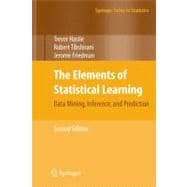
Note: Supplemental materials are not guaranteed with Rental or Used book purchases.
Purchase Benefits
What is included with this book?
| Introduction | |
| Overview of supervised learning | |
| Linear methods for regression | |
| Linear methods for classification | |
| Basis expansions and regularization | |
| Kernel smoothing methods | |
| Model assessment and selection | |
| Model inference and averaging | |
| Additive models, trees, and related methods | |
| Boosting and additive trees | |
| Neural networks | |
| Support vector machines and flexible discriminants | |
| Prototype methods and nearest-neighbors | |
| Unsupervised learning | |
| Table of Contents provided by Publisher. All Rights Reserved. |
The New copy of this book will include any supplemental materials advertised. Please check the title of the book to determine if it should include any access cards, study guides, lab manuals, CDs, etc.
The Used, Rental and eBook copies of this book are not guaranteed to include any supplemental materials. Typically, only the book itself is included. This is true even if the title states it includes any access cards, study guides, lab manuals, CDs, etc.